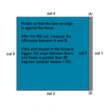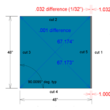Home : 32mm : Tools : Cutting :
 The 5-cut method is a very accurate way to check a sliding table, sled or miter fence for squareness to the sawblade. I ran across this while watching a Laguna Tools video. Hopefully the drawing is self descriptive. Different setups will call for either a clockwise or counterclockwise rotation. The example image is for a front fence to the left of the blade (counterclockwise). With the same setup and the fence to the rear, the rotation would be counterclockwise. In any case, if the wider end of the cutoff piece is closer to the blade, the fence is greater than 90 degrees to the blade (smaller is less than 90). The bigger the piece of material you use, the more accurate you can be.
The 5-cut method is a very accurate way to check a sliding table, sled or miter fence for squareness to the sawblade. I ran across this while watching a Laguna Tools video. Hopefully the drawing is self descriptive. Different setups will call for either a clockwise or counterclockwise rotation. The example image is for a front fence to the left of the blade (counterclockwise). With the same setup and the fence to the rear, the rotation would be counterclockwise. In any case, if the wider end of the cutoff piece is closer to the blade, the fence is greater than 90 degrees to the blade (smaller is less than 90). The bigger the piece of material you use, the more accurate you can be.
 I made the image at right with Drafix CAD. I figure that a 32nd of an inch is as accurate as you can get with a tape measure. As you can see a 1/32" difference with the five cut method equals a mere .001" difference on the diagonal. Diagonal measuring doesn't work if you really want to be square. If you *really* want to get precise you can use a caliper with this method. You do need to consider the limits of your tooling, how much slop is in the runners or bearings etc., before trying to get within .001 (probably totally unrealistic) with this method... This is a bit overstated in that you typically have two parallel edges and your crosscuts will have two angles greater than 90 and 2 angles less than 90, not the four greater than 90 in the drawing, i.e. there would be a bigger difference on the diagonal.
I made the image at right with Drafix CAD. I figure that a 32nd of an inch is as accurate as you can get with a tape measure. As you can see a 1/32" difference with the five cut method equals a mere .001" difference on the diagonal. Diagonal measuring doesn't work if you really want to be square. If you *really* want to get precise you can use a caliper with this method. You do need to consider the limits of your tooling, how much slop is in the runners or bearings etc., before trying to get within .001 (probably totally unrealistic) with this method... This is a bit overstated in that you typically have two parallel edges and your crosscuts will have two angles greater than 90 and 2 angles less than 90, not the four greater than 90 in the drawing, i.e. there would be a bigger difference on the diagonal.
Square Cutting Panels
 The 5-cut method is a very accurate way to check a sliding table, sled or miter fence for squareness to the sawblade. I ran across this while watching a Laguna Tools video. Hopefully the drawing is self descriptive. Different setups will call for either a clockwise or counterclockwise rotation. The example image is for a front fence to the left of the blade (counterclockwise). With the same setup and the fence to the rear, the rotation would be counterclockwise. In any case, if the wider end of the cutoff piece is closer to the blade, the fence is greater than 90 degrees to the blade (smaller is less than 90). The bigger the piece of material you use, the more accurate you can be.
The 5-cut method is a very accurate way to check a sliding table, sled or miter fence for squareness to the sawblade. I ran across this while watching a Laguna Tools video. Hopefully the drawing is self descriptive. Different setups will call for either a clockwise or counterclockwise rotation. The example image is for a front fence to the left of the blade (counterclockwise). With the same setup and the fence to the rear, the rotation would be counterclockwise. In any case, if the wider end of the cutoff piece is closer to the blade, the fence is greater than 90 degrees to the blade (smaller is less than 90). The bigger the piece of material you use, the more accurate you can be. I made the image at right with Drafix CAD. I figure that a 32nd of an inch is as accurate as you can get with a tape measure. As you can see a 1/32" difference with the five cut method equals a mere .001" difference on the diagonal. Diagonal measuring doesn't work if you really want to be square. If you *really* want to get precise you can use a caliper with this method. You do need to consider the limits of your tooling, how much slop is in the runners or bearings etc., before trying to get within .001 (probably totally unrealistic) with this method... This is a bit overstated in that you typically have two parallel edges and your crosscuts will have two angles greater than 90 and 2 angles less than 90, not the four greater than 90 in the drawing, i.e. there would be a bigger difference on the diagonal.
I made the image at right with Drafix CAD. I figure that a 32nd of an inch is as accurate as you can get with a tape measure. As you can see a 1/32" difference with the five cut method equals a mere .001" difference on the diagonal. Diagonal measuring doesn't work if you really want to be square. If you *really* want to get precise you can use a caliper with this method. You do need to consider the limits of your tooling, how much slop is in the runners or bearings etc., before trying to get within .001 (probably totally unrealistic) with this method... This is a bit overstated in that you typically have two parallel edges and your crosscuts will have two angles greater than 90 and 2 angles less than 90, not the four greater than 90 in the drawing, i.e. there would be a bigger difference on the diagonal.
